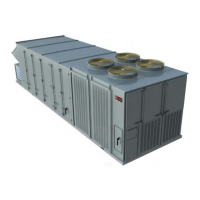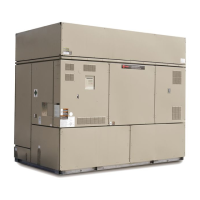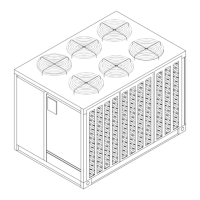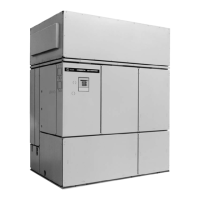156
RT-SVX24Q-EN
NNoottee:: Bridging between the unit main supports may
consist of multiple 2 x 12 boards or sheet metal
grating.
Arbitrarily adjusting the outside air dampers to open
fully when the return air dampers are closed or; failing
to maintain the return air pressure drop with the
outside air dampers when the return air dampers are
closed, can overload the supply fan motor and cause
building pressurization control problems due to
improper CFM being delivered to the space.
The outside air/return air damper linkage is connected
to a crank arm with a series of holes that allows the
installer or operator to modify the amount of outside
air damper travel in order to match the return static
pressure.
Refer to Table 55, p. 158 for the equivalent return air
duct losses that correspond to each of the holes
illustrated in Figure 122, p. 157.
To Adjust the Outside Air Damper Travel
1. Drill a 1/4" hole through the unit casing up stream
of the return air dampers. Use a location that will
produce an accurate reading with the least amount
of turbulence – several locations may be necessary,
then average the reading.
WWAARRNNIINNGG
HHaazzaarrddoouuss VVoollttaaggee!!
FFaaiilluurree ttoo ddiissccoonnnneecctt ppoowweerr bbeeffoorree sseerrvviicciinngg ccoouulldd
rreessuulltt iinn ddeeaatthh oorr sseerriioouuss iinnjjuurryy..
DDiissccoonnnneecctt aallll eelleeccttrriicc ppoowweerr,, iinncclluuddiinngg rreemmoottee
ddiissccoonnnneeccttss bbeeffoorree sseerrvviicciinngg.. FFoollllooww pprrooppeerr
lloocckkoouutt//ttaaggoouutt pprroocceedduurreess ttoo eennssuurree tthhee ppoowweerr
ccaann nnoott bbee iinnaaddvveerrtteennttllyy eenneerrggiizzeedd.. VVeerriiffyy tthhaatt nnoo
ppoowweerr iiss pprreesseenntt wwiitthh aa vvoollttmmeetteerr..
IImmppoorrttaanntt:: HIGH VOLTAGE IS PRESENT AT
TERMINAL BLOCK OR UNIT
DISCONNECT SWITCH.
2. Close the disconnect switch or circuit protector
switch that provides the supply power to the unit
terminal block or the unit mounted disconnect
switch.
3. Turn the 115 volt control circuit switch and the 24
volt control circuit switch to the On position.
4. Open the Human Interface access door located in
the unit control panel, and press the SERVICE
MODE key to display the first service screen. Refer
to the latest edition of the applicable programming
manual for applications for the SERVICE TEST
screens and programming instructions.
5. Use tables in “Voltage Imbalance,” p. 105 to
program the following system components for
operation by scrolling through the displays;
• Supply Fan (On)
• Variable Frequency Drive (100% Output, if
applicable)
• RTM Occ/Unocc Output (Unoccupied)
• Outside Air Dampers (Closed)
6. Once the configuration for the components is
complete, press the NEXT key until the LCD
displays the “Start test in __Sec.” screen. Press the
+ key to designate the delay before the test is to
start. This service test will begin after the TEST
START key is pressed and the delay designated in
this step has elapsed. Press the ENTER key to
confirm this choice.
7. Press the TEST START key to start the test.
Remember that the delay designated in step 6 must
elapse before the fan will begin to operate.
8. With the outside air dampers fully closed and the
supply fan operating at 100% airflow requirements,
measure the return static pressure at the location
determined in step 1.
9. Press the STOP key at the Human Interface Module
in the unit control panel to stop the fan operation.
WWAARRNNIINNGG
LLiivvee EElleeccttrriiccaall CCoommppoonneennttss!!
FFaaiilluurree ttoo ffoollllooww aallll eelleeccttrriiccaall ssaaffeettyy pprreeccaauuttiioonnss
wwhheenn eexxppoosseedd ttoo lliivvee eelleeccttrriiccaall ccoommppoonneennttss ccoouulldd
rreessuulltt iinn ddeeaatthh oorr sseerriioouuss iinnjjuurryy..
WWhheenn iitt iiss nneecceessssaarryy ttoo wwoorrkk wwiitthh lliivvee eelleeccttrriiccaall
ccoommppoonneennttss,, hhaavvee aa qquuaalliiffiieedd lliicceennsseedd eelleeccttrriicciiaann
oorr ootthheerr iinnddiivviidduuaall wwhhoo hhaass bbeeeenn pprrooppeerrllyy ttrraaiinneedd
iinn hhaannddlliinngg lliivvee eelleeccttrriiccaall ccoommppoonneennttss ppeerrffoorrmm
tthheessee ttaasskkss..
WWAARRNNIINNGG
RRoottaattiinngg CCoommppoonneennttss!!
FFaaiilluurree ttoo ddiissccoonnnneecctt ppoowweerr bbeeffoorree sseerrvviicciinngg ccoouulldd
rreessuulltt iinn rroottaattiinngg ccoommppoonneennttss ccuuttttiinngg aanndd ssllaasshhiinngg
tteecchhnniicciiaann wwhhiicchh ccoouulldd rreessuulltt iinn ddeeaatthh oorr sseerriioouuss
iinnjjuurryy..
DDiissccoonnnneecctt aallll eelleeccttrriicc ppoowweerr,, iinncclluuddiinngg rreemmoottee
ddiissccoonnnneeccttss bbeeffoorree sseerrvviicciinngg.. FFoollllooww pprrooppeerr
lloocckkoouutt//ttaaggoouutt pprroocceedduurreess ttoo eennssuurree tthhee ppoowweerr
ccaann nnoott bbee iinnaaddvveerrtteennttllyy eenneerrggiizzeedd..
10. Open the field supplied main power disconnect
switch upstream of the rooftop unit. Lock the
disconnect switch in the “Open” position while
working on the dampers.
NNoottee:: Gravity will cause the damper to close.
Support or secure the damper blades while
removing the actuator to prevent unexpected
damper rotation.
11. Compare the static pressure reading to the static
pressure ranges and linkage positions in Table 55,
p. 158 for the unit size and operating CFM.
Relocate the outside air/return air connecting rod to
balance the outside air damper pressure drop
UUnniitt SSttaarrttuupp
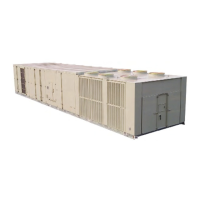
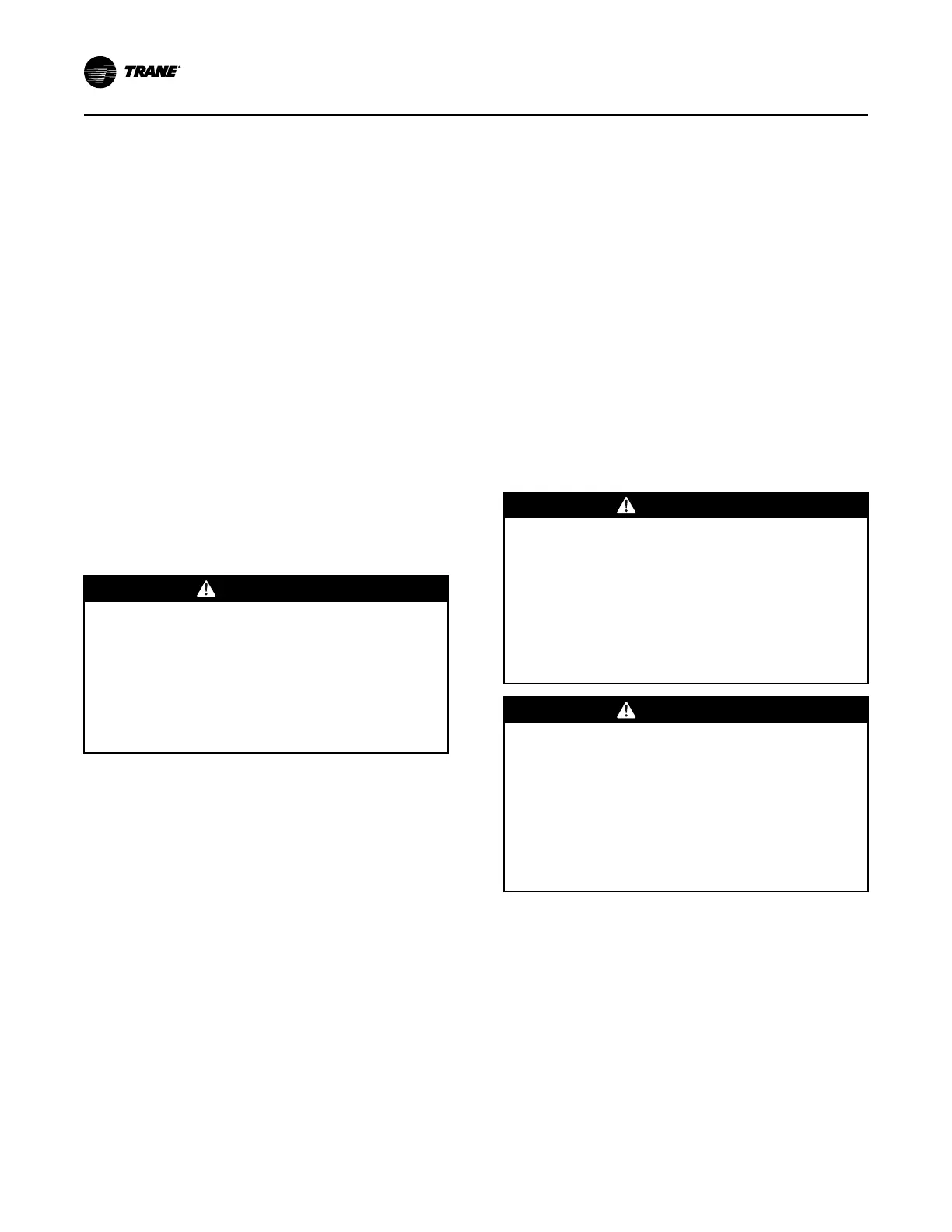